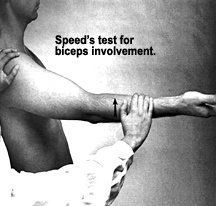Recent laws in New Jersey and California represent a disturbing trend that will negatively impact a practice’s ability to collect monies from patients, as well as expose them to significant penalties if the practice does not follow the mandatory guidelines to a T. Please be aware that a similar law may be coming to your state. The time to act is before the law is passed.
Speed's Test Has Lost Its Speed
Recently, a patient with anterior shoulder pain who had received a cortisone injection into her biceps tendon reported that it did not alleviate her shoulder pain. I inquired as to how the doctor had determined that her biceps were involved. She said he palpated the area that was tender and did a test - she held her shoulder extended in front of her, with her hand supinated, and resisted his downward pressure. She said doing so was painful. The doctor had performed Speed's test for biceps involvement.

I have always regarded a positive functional test as more valid than tenderness over an area. Here is a case in which they both are equivocal. In the recent AJSM study,1 847 patients underwent diagnostic arthroscopy of the shoulder and 40 were found to have partial biceps tears, to which Speed's test and palpation was pretested. The sensitivity and specificity tests were about 50 percent accurate when palpation and Speed's test were used.
The authors state that palpation of the biceps tendon is difficult because it lies deep in the shoulder and is covered by other structures. It is especially difficult in obese or heavily muscled subjects. The lever-arm position of the biceps in the Speed's test stimulates many of the surrounding muscles. Shoulder motion does not produce any electrical activity in the biceps muscle but becomes electrically active with elbow flexion and extension.1 Probably the best way to test the biceps is with the elbow in 90 degree flexion with the arm in supination, held against the trunk.2
References
- Gill HS, El Rassi G, Bahk MS, et al. Physical examination for partial tears of the biceps tendon. Am J Sports Med, 2007;35(8):1334-40.
- Hammer WI. Functional Soft tissue Examination and Treatment by Manual Methods. Sudbury, Mass.: Jones and Bartlett.



